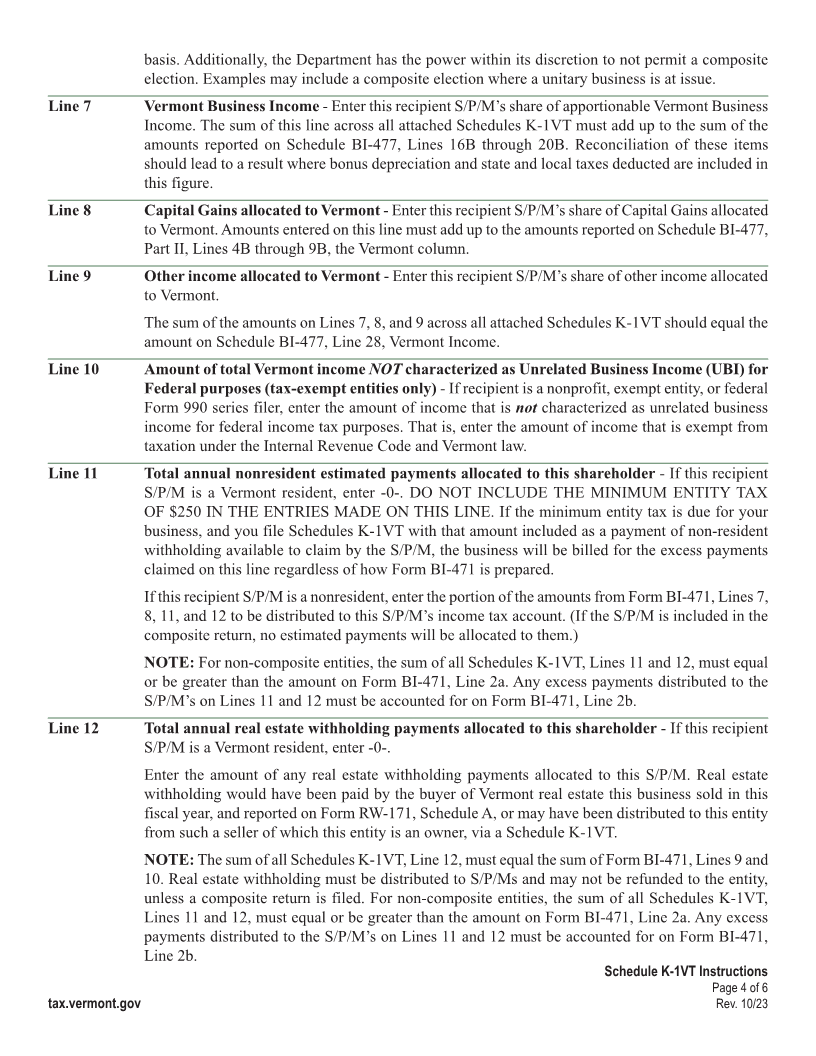
Enlarge image
SCHEDULE K-1VT Instructions
Shareholder, Partner, or Member Information
Page 1
General Information
Please print in BLUE or BLACK ink only.
Schedule K-1VT reports the income sourced to Vermont earned by a business entity that is passed
through to the owners. In general, pass-through entities, including S-Corporations, Partnerships,
and some Limited Liability Companies, should include a Schedule K-1VT for each Shareholder,
Partner, or Member (S/P/M) with their Form BI-471, Vermont Business Income Tax Return. There
are exceptions for composite returns, described below.
Every business must provide each S/P/M with a copy of their Schedule K-1VT on or before the due
date of Form BI-471.
Businesses that file Form BI-476, Business Income Tax Return (For Residents Only), instead
of Form BI-471 should not include Schedule(s) K-1VT with the return. They may prepare the
INSTR (Place at FIRST page)
schedule(s) and provide them to the owner(s) if desired. Instr. pages
For detailed information on filing requirements and definitions of income and residency, refer to
the following resources, available on the Department’s website:
• 32 V.S.A., § 5811, § 5823, § 5861, § 5912, § 5914, § 5920
1 - 6
• Technical Bulletin TB-06, Estimated Payments by Corporations, Partnerships and
Limited Liability Companies on Behalf of Shareholder
Complete a Separate Schedule K-1VT for each S/P/M
COMPOSITE RETURNS: If the business has elected or is required to file a composite return to
report and pay tax for its S/P/Ms who are Vermont nonresidents, consolidate their information onto
a single Schedule K-1VT. The “recipient” information (name, FEIN, etc.) should be that of the
reporting business entity. The percent ownership and other numerical fields should be the sum of
the figures for all owners included in the composite filing. Mark the “Composite” checkbox “Yes.”
Exception: If the entity is distributing any income to owners (individuals or entities) that are
treating the income as exempt from tax, attach Schedule K-1VTs for those owners to Form BI-471.
The entity may, at its discretion, complete a Schedule K-1VT for each separate owner that is
included in the composite filing. An example of where this might be helpful would be if one or more
owner in the composite filing has a Vermont income tax filing requirement due to other Vermont
activity. Schedule K-1VT would demonstrate the income distributed, which would be deducted
from the owner’s income tax return in order to avoid double-taxation. These Schedules K-1VT
should not be attached to Form BI-471 filed with the Department.
Line 11 would be -0-. Estimated payments would not pass through to owners, but would be applied
as a credit against tax at the entity level.
NOTE: If an entity files a composite return, all Vermont nonresidents must be included in the
composite filing. “Partial composite” returns will not be accepted.
Schedule K-1VT Instructions
Page 1 of 6
tax.vermont.gov Rev. 10/23




